VOS DENTS SONT DÉCHAUSSÉES OU PERDUES? RECONSTRUISEZ VOTRE SOURIRE EN UNE SEMAINE
REMPLACEZ VOS DENTS MALADES GRÂCE AUX PROTOCOLES DE POSE D'IMPLANTS AVEC MISE EN ESTHÉTIQUE IMMÉDIATE
INTROdUCTION à L'Implantologie avec Mise en Charge Immédiate:
Refaites EntiÈrement votre sourire SOUS SÉDATION EN QUELQUES JOURS
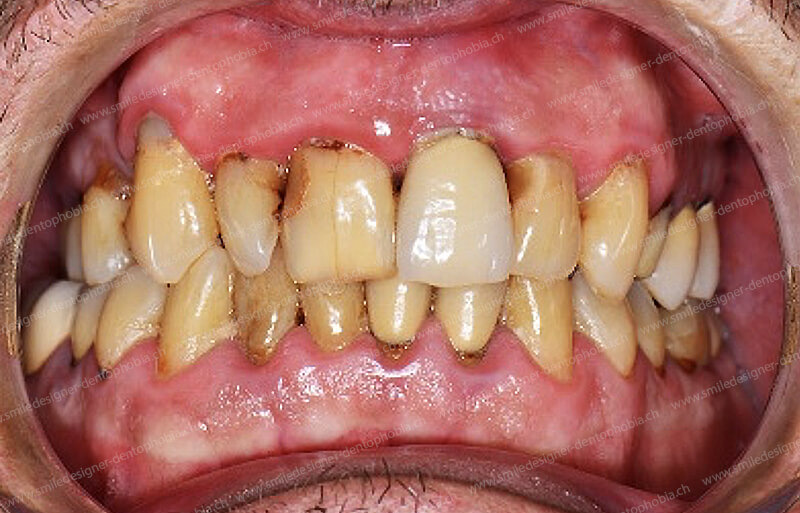
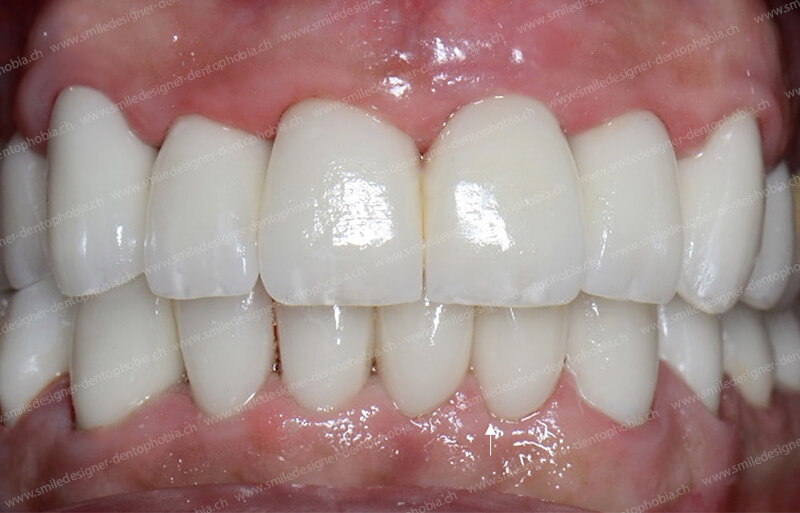


" ON NE RÉSOUD PAS UN PROBLÈME AVEC LES MODES DE PENSÉE QUI L'ONT ENGENDRÉ "
ALBERT EINSTEIN
TOUT ce que vous avez toujours voulu savoir
pour refaire votre sourire en quelques jours
découvrez les nouveaux paradigmes et l'univers de la pose d'implants en MCI
LEs grands BRIDGEs SUR IMPLANTS EN MCI DE MOLAIRE À MOLAIRE:
“ALL ON 10 / 8”
LEs petits BRIDGEs SUR IMPLANTS EN MCI DE PRÉMOLAIRE À PRÉMOLAIRE:
“ALL ON 8 / 6”
Apprenez dans les pages du chapitre « NOTRE UNIVERS : l’IMPLANTOLOGIE AVEC MISE EN CHARGE IMMÉDIATE – MCI »
Tout ce que vous devez savoir pour refaire votre bouche, en quelques jours, avec un des protocoles implantaires permis les plus modernes :
- La pose d’implants dentaires avec une Mise en Charge et en Esthétique Immédiate grâce à un bridge implanto-porté de reconstruction totale de votre sourire, ainsi que de votre fonction masticatrice.
- Un protocole de pose d’implants en une seule intervention chirurgicale, dites en « one shot »;
- Des bridges esthétiques de reconstruction de vos dentures en moins d’une semaine.
A qui s’adresse notre protocole de pose d’implants dentaires en mise en charge immédiate « Gold Standard MCI »?
Le « Gold Standard MCI » est une reconstruction totale de votre bouche grâce à la pose d’un nombre maximum d’implants dentaires, y compris dans les secteurs postérieurs des maxillaires, supérieurs et inférieurs.
1/ Notre protocole de pose d’implants dentaires en Mise en Charge Immédiate, dit « Gold Standard MCI », s’adresse aux patients les plus exigeants et désireux d’une reconstruction de leurs arcades dentaires dite « ad integrum », c’est-à-dire « une réparation intégrale ».
À condition toutefois que leur cas clinique soit éligible aux indications de ce protocole.
Or, il est malheureusement souvent le cas que les molaires, c’est-à-dire les dents les plus postérieures de vos arcades dentaires, soient extraites de façon précoce. La conséquence de ces extractions est une fonte de l’os alvéolaire. C’est-à-dire l’os qui entoure et retient les dents. Les molaires disparaissant, l’os autour de ces dents disparaît avec elles.
Dans certains cas cliniques favorables, il est possible de poser les implants dans des secteurs postérieurs:
- Soit, directement et sans intervention pré-implantaires préalables, parce que l’os alvéolaire des molaires ne s’est pas totalement résorbé et permet la pose des implants directement ;
- Soit parce que des greffes osseuses, en particulier des greffes dans le sinus ou « sinus lift » au maxillaire supérieur, ont permis de reconstruire l’os résorbé au niveau des molaires et notamment, des molaires supérieures.
Dans ces cas cliniques, soit d’ores et déjà favorables ou soit, rendus favorables par des greffes osseuses pré-implantaires, la pose d’implants, dans les zones les plus postérieures de l’arcade dentaire, permet une reconstruction totale de l’ensemble de votre denture, grâce à l’installation de bridges implanto-portés.
Les avantages sont immédiats, au bout d’une semaine:
- Une restructuration idéale de la mastication ;
- Un calage parfait de la morsure, que l’on appelle « l’occlusion inter maxillaire » ;
- Une restructuration totale du sourire et de l’expression du visage.
Ce calage de l’occlusion, au niveau le plus postérieur, protège les articulations temporo-mandibulaires (ATM). C’est-à-dire l’articulation entre la mâchoire inférieure (appelée mandibule) et le crâne, au niveau de l’avant des conduits auditifs des oreilles.
2/ Notre protocole de pose d’implants dentaires en Mise en Charge Immédiate, dit « Gold Standard MCI », s’adresse également aux patients de forte carrure qui ne peuvent s’accommoder d’un nombre restreint d’implants.
Il y a une loi de la physique élémentaire qui dit que la pression est égale à la force divisée par la surface : P= F/S.
Or, plus le gabarit du patient est fort, plus sa force de mastication est importante.
En conséquence, le nombre d’implants devra être augmenté au maximum afin que la pression sur chaque implant soit réduite au minimum. Une pression réduite sur chaque implant permet de minimiser les risques de fracture ou de résorption osseuse péri-implantaire.
3/ C’est précisément l’exemple du cas clinique décrit dans notre film « Implants en MCI »:
La patient de ce film est un très grand garçon, costaud.
Il était édenté complet au maxillaire et diagnostiqué d’une parodontite terminale à la mandibule.
Il était en détresse psychologique extrême car sans solution, jusqu’à ce que nous le prenions en charge.
Au maxillaire, nous avons posé 10 implants selon notre protocole « Gold Standard MCI » All on 10.
- Le maxillaire supérieur a été préalablement reconstruit par deux greffes osseuses sous sinusiennes, type « sinus lift », bilatérales.
- Nous avons pratiqué, également, au maxillaire, deux greffes osseuses de reconstruction osseuse de la crête alvéolaire par ostéosynthèse, associées aux techniques de dentisterie régénérative. Ces greffes sont situées au niveau des canines pour compenser la perte de substance suite à deux kystes infectés de l’os alvéolaire.
A la mandibule, nous avons posé 8 implants selon notre protocole « Gold Standard MCI » All on 8.
Grâce à deux mini implants dans les régions postérieures molaires mandibulaires nous avons réussit à reconstruire la fonction masticatrice molaire.
En conséquence :
- Tous les implants postérieurs maxillaires sont vissés dans cet os greffé, au maxillaire.
- Les deux bridges implanto-portés remplacent l’intégralité des dents naturelles de ce patient, de molaire à molaire, avec une mise en charge immédiate ou MCI.
- Le nombre d’implants élevé est nécessaire et suffisant en rapport taille /poid de ce patient d’1,90 m pour 100 kg.
Ces deux techniques All on 10 et All on 8 sont rendues possible par une cascade de chirurgies pré-implantaires des plus sophistiquées :
Nous appelons notre protocole pour les gestion des cas complexe le « Domino Surgeries MCI ». Ce concept de chirurgies orales en cascade est développé dans le chapitre correspondant.
Notre protocole de pose d’implants dentaires en Mise en Charge Immédiate, dit « Gold Standard MCI » permet un résultat optimisé. Il est un des plus satisfaisants actuellement, tant sur le plan de la mastication que de l’esthétique du sourire.
Grâce à la pose d’un nombre suffisamment important d’implants dentaires pour supporter une prothèse implanto-portée de type bridge céramique fixe transvissée, cet homme a redémarré une nouvelle vie.
Dans ces chapitres nous allons tenter de vous expliquer quels sont les prérequis indispensables à la pose d’implants dans les secteurs postérieurs des maxillaires.
Certaines personnes sont dans une situation dentaire désespérés !
En particulier, à cause d’une résorption osseuse extrême qui interdit la pose des implants. Cette contre-indication à la pose des implants rend donc très difficiles les interventions en implantologie en MCI.
Le chirurgien implantologue pour lever ces contre-indications est obligé de pratiquer une cascade d’interventions chirurgicales, appelées « greffes osseuses pré-implantaires.
Pour reconstruire les maxillaires et compenser la perte de substance osseuse, conséquence de la résorption physiologique et automatique de l’os, immédiatement à la suite des extractions dentaires, une succession de greffes osseuses est programmée.
Ces reconstructions osseuses sont le prérequis à la pose des implants dentaires et la fixation, sur ces derniers, d’un bridge complet implanto-porté en mise en charge et en esthétique immédiate.
Nous appelons cette cascade d’intervention chirurgicales dans nos protocoles « Domino Surgeries MCI ». Ce thème sera développé dans le chapitre correspondant.
Dans le cas où il n’est pas possible de programmer un protocole « Domino Surgeries MCI » permettant de poser des implants dans les secteurs postérieurs notre protocole de secours le « DAMAGE CONTROL MCI » prend le relai.
Notre protocole de secours urgents aux patients en détresse, le « Damage Control MCI », se substitue au protocole de premier intention le « Gold Standard MCI » :
- Soit, parce que le patient décide que la reconstruction partielle, mais suffisante, du « Damage Control MCI » lui convient et qu’il veut se dispenser de faire d’autres interventions chirurgicales, par manque de temps, d’envie ou d’argent ;
- Soit, parce que, comme ses dents sont d’ores et déjà tombées ou, en passe de tomber dans un avenir très proche, il souhaite avant toutes choses de trouver une solution pour ne pas être édenté et donc désocialisé.
Le protocole « Damage Control MCI » est développé dans le chapitre correspondant.
Premier principe : A qui s’adresse notre protocole « Domino Surgeries MCI » et en particulier, les greffes osseuses intra-sinusiennes ou Sinus Lift?
Nous avons vu que le protocole de pose d’implants dentaires en Mise en Charge Immédiate dit « Gold Standard MCI » est une reconstruction total de votre bouche, grâce la pose d’un nombre maximum d’implants dentaires, y compris dans les secteurs postérieurs des maxillaires.
À condition toutefois que votre cas clinique soit éligible aux indications de ce protocole.
Or, il est malheureusement souvent le cas que les molaires, c’est-à-dire les dents les plus postérieures de vos arcades dentaires, soient extraites de façon précoce. La conséquence de ces extractions est une fonte de l’os alvéolaire, c’est-à-dire l’os qui entoure et retient les dents. Les molaires disparaissant, l’os autour de ces dents disparaît avec elles.
Dans ces cas cliniques défavorables, il n’est pas possible de poser les implants dans les secteurs postérieurs, parce que l’os alvéolaire des molaires s’est totalement résorbé et ne permet pas la pose des implants.
Pour résoudre ce problème et rendre la pose des implants possible, il faudra réaliser des greffes osseuses. En particulier des greffes de comblement du bas-fond des sinus ou « sinus lift » au maxillaire supérieur de manière à reconstruire le volume d’os alvéolaire résorbé.
Deuxième principe : Le comblement du bas-fond des sinus ou « sinus lift » est un prérequis dans le protocole de pose d’implants dentaires en mise en charge immédiate. En particulier, pour la réalisation d’un « Gold Standard MCI ».
Cette compensation de la résorption de l’os postérieur molaire sous sinusien au maxillaire n’est pas l’unique contre-indication à la pose d’implants dentaires!
Car dans certains cas cliniques très défavorables, où les maxillaires sont fortement atrophiés, la résorption osseuse concerne aussi la zone prémolaire à l’arrière des canines, voir même la zone antérieure des dents du sourire.
Dans ces cas de figures très difficiles, même le « Damage Control MCI » ne suffit pas a régler les problèmes.
La mise en place du protocole « Domino Surgeries MCI » est indispensable pour ces situations de détresse.
Ces cas de figures et leurs variantes sont décrits dans les chapitres concernant les bridges implanto-portés en MCI au maxillaire et à la mandibule.
Lors de l’indication de la mise en place du protocole «Domino Surgeries MCI», une succession de greffes osseuses de reconstruction, en cascade, est envisagée et planifiée.
L’effet « Domino » conduit, de chirurgie en chirurgie préimplantaires, à la reconstruction des bases osseuses et la pose des implants dentaires avec une Mise en Charge Immédiate par un bridge complet implanto-porté.
Une fois le volume osseux postérieur des maxillaires reconstruit nous pouvons envisager de réaliser notre protocole de pose d’implants dentaires en Mise en Charge Immédiate, dit « Gold Standard MCI ».
Troisième principe : L’effet « Domino » des chirurgies pré-implantaires conduit in fine à la reconstruction des bases osseuses : c’est précisément l’exemple du cas clinique décrit dans notre film « Le sinus lift ».
Dans ce cas clinique extrêmement difficile à cause d’une résorption quasi-totale de la partie postérieure du maxillaire avec une forte pneumatisation des sinus, les deux côtés du maxillaire supérieurs ont été, préalablement à la pose des implants, reconstruit par deux greffes osseuses sous sinusiennes, dites « Sinus Lift », bilatérales.
Le résultat de ce cas clinique est totalement satisfaisant puisque nous avons entièrement reconstruit les deux arcades dentaires de cette patiente.
Dans ce cas précis il s’agit, d’une variante du «Gold Standard MCI» car nous n’avons pas posé 10 implants au maxillaire et 8 à la mandibule, mais 8 implants au maxillaire et 8 à la mandibule.
En effet, le gabarit de cette petite dame ne permettait pas d’en poser plus !
- Au maxillaire, nous avons posé 8 implants selon notre protocole « Gold Standard MCI » All on 8.
- A la mandibule, nous avons posé 8 implants selon notre protocole « Gold Standard MCI » All on 8.
Comme nous l’avons déterminé dans l’article sur le «Gold Standard MCI», il faut tenir compte du gabarit du patient et de sa force : on envisage pas un traitement d’implantologie pour un grand gaillard de 100 kg, comme pour une petite dame de 50 kg.
Le principe de la démonstration par l’image :
Dans notre film « le sinus lift » : la patiente est une frêle et charmante dame, diagnostiquée d’une parodontite terminale bi maxillaire. Elle était vouée à être totalement édentée sous peu.
La désertification médicale de sa région d’habitation et la complicité de son cas clinique pour des omnipraticiens l’a privé de solution pérenne. Sans solution technique pour éviter un « dentier », elle était en errance médicale, jusqu’à ce que nous la prenions en charge.
La MCI était totalement impossible à réaliser sans pratiquer les deux Sinus Lift bilatéraux.
Malheureusement, elle ne disposait pas d’un volume osseux suffisant, même avec des mini implants, pour poser les implants nécessaires dans la région maxillaire postérieure.
Au maxillaire : Nous avons été obligés de reconstruire le volume osseux sous sinusien qui s’est résorbé à la suite des extractions dentaires.
Cette chirurgie de greffes osseuse entre le sinus et l’os résiduel du maxillaire s’appelle un comblement de sinus ou sinus lift.
À la mandibule : Avec la pose de mini implants, nous avons pu poser des implants dentaires au-delà de la région de la sortie du nerf alvéolaire inférieur, afin d’être le plus postérieur possible et remplacer les molaires.
Le résultat clinique :
On constate sur la radiographie de contrôle à la fin du traitement que, de chaque côté, les 3 implants postérieurs sur les 4 posés sont intégralement vissés dans l’os greffé.
Grâce à ce nombre d’implants augmenté, nous avons pu fixer deux bridges implanto-portés, haut et bas, avec des molaires qui restaurent la quasi-totalité de la fonction occlusale et masticatrice de notre patiente.
Grâce à deux mini implants dans les régions postérieures molaires mandibulaires, nous avons réussi à reconstruire la fonction masticatrice molaire.
En conséquence :
- Tous les implants postérieurs maxillaires sont vissés dans cet os greffé, au maxillaire : c’est le résultat du «Domino Surgeries MCI»
- Les deux bridges implanto-portés remplacent l’intégralité des dents naturelles de ce patient, de molaire à molaire, avec une mise en charge immédiate ou MCI : c’est le résultat du « Gold Standard MCI ».
- Le nombre d’implants élevé, mais optimisé, est en rapport taille/poid de cette patiente d’1,69 m pour 55 kg.
En conclusion : Ces deux techniques « All on 8 » au maxillaire et « All on 8 » à la mandibule sont rendues possible par une cascade de chirurgies pré-implantaires des plus sophistiquées : c’est ce protocole que nous avons baptisé « Domino surgeries MCI ».
Notre protocole de pose d’implants dentaires en Mise en Charge Immédiate, dit « Gold Standard MCI » permet un résultat très optimisé, qui est des plus satisfaisants, tant sur le plan de la mastication que de l’esthétique du sourire.
Grâce à la pose d’un nombre suffisamment important d’implants dentaires pour supporter une prothèse implanto-portée de type bridge céramique fixe transvissée, cette femme a redémarré une nouvelle vie.
Smile designer vous présente son catalogue de protocoles mci : NOS solutions pour chaque situations d'édentements.
NOS SOLUTIONS en mci POUR STABILISER LE PATIENT PHYSIQUEMENT, SOCIALEMENT ET ÉMOTIONNELLEMENT
DANS CE CHAPITRE NOUS VOUS PRÉSENTONS NOTRE CATALOGUE DE SOLUTIONS POUR REMPLACER TOUTES LES DENTS PAR DES IMPLANTS DENTAIRES EN MISE EN CHARGE IMMÉDIATE.
Toute la problématique de la pose des implants en mise en charge immédiate et le remplacement de toutes les dents de l’arcade par un bridge implanto-porté en mise en charge immédiate est la quantité de volume osseux implantable, totalement ou partiellement disponible, en particulier dans les secteurs postérieurs des maxillaires.
Dans les cas clinique de parodontite terminale (déchaussement des dents) ou bien de kystes péri-apicaux étendus (kystes endodontiques aux bouts des racines dentaires), il est fréquent que le volume osseux des maxillaires soit totalement atrophié.
Cette situation est particulièrement fréquente au niveau des secteurs postérieurs des maxillaires et surtout au niveau du maxillaire supérieur :
Dans ces situations critiques, le volume osseux disponible n’est pas suffisant pour poser des implants dentaires pour remplacer les dents postérieures prémolaires et/ou molaires.
Il y a également des cas cliniques qui présentent ce même type de résorption osseuse sur le secteur antérieur:
Dans ce cas de figure, s’il n’y a pas de résorption osseuse dans les secteurs postérieurs, il est relativement aisé de fixer un bridge implanto-porté qui remplace les dents postérieures et servent d’appui pour reconstruire le secteur antérieur.
En revanche, si les secteurs antérieurs et postérieurs sont tous les deux totalement atrophiés, sera très difficile de poser des implants :
Soit, la solution du comblement de sinus bilatéraux sera retenu et nous nous retrouvons dans la situation précédente. Soit, il ne sera pas possible d’effectuer ces interventions et dans ce cas la pose d’implants zygomatiques sera la seule solution, en remplacement d’une prothèse amovible complète.
Des greffes pré-implantaires doivent être réalisées pour reconstruire ce volume osseux perdu.
C’est technique sont connues et bien cataloguées. Il n’y a aucun problème à les mettre en oeuvre. Toutes ces techniques sont décrites dans tous les chapitres de notre site internet.
Mais ces interventions prennent du temps de cicatrisation !…
Il faut que le patient accepte de consacrer du temps opératoire et lui additionner le temps de cicatrisation. C’est à dire quatre mois de cicatrisation osseuses plus éventuellement quatre mois d’ostéointégration des implants, dans les cas de cascade chirurgicale. Dans certain cas favorable, ces deux temps de cicatrisation sont confondus.
Si, le patient est dans une situation clinique qui ne met pas en péril ses dents antérieures, il n’y a pas de problème à prendre son temps pour réaliser ces cascades d’interventions de chirurgies préimplantaires afin de reconstruire les secteurs postérieurs.
Ces techniques de « Sinus lift », par exemple, sont décrites dans notre chapitre sur l’implantologie conventionnelle en « one shot », sous anesthésie générale.
Mais la situation est totalement différente lorsque l’indication d’une extraction avec implantation en mise en charge immédiate est posée, puisque par définition la situation clinique du patient est un péril, qui peut être quasi immédiat.
Donc, par nature, cette situation clinique implique que le secteur antérieur soit condamné tout autant que les secteurs postérieurs.
Les cas de figures cliniques les plus favorables à une pose d’implants en Mise en Charge Immédiates sont traités dans nos deux premières solutions:
– Solution 1 « Gold Standard MCI » : cliquez ici
– Solution 2 « Gold Damage Control MCI » : cliquez ici
Dans ces cas de figures cliniques, le patient présente une structure osseuse maxillaire d’un volume favorable. Nous arrivons à reconstruire complètement le patient en une seule intervention chirurgicale et la pose d’une prothèse implanto-portée quelques jours plus tard.
Bien évidemment cette première version de bridge transvissé sur les implants dentaires avec un cosmétique résilient n’est pas définitive, mais elle est suffisamment confortable pour être conservée les 6 à 12 mois de temps de cicatrisation, en attendant la pose du bridge implanto-porté avec un cosmétique en céramique définitif.
Mais, il y a des situations clinique encore plus graves, où le patient est dans une situation critique telle que ses dents antérieures tout autant que postérieures sont toutes en train « de tomber », dans un avenir quasi immédiat, le projetant dans une situation personnelle et professionnelle catastrophique.
Et si, comble de malchance, la résorption osseuse postérieure (voir antérieure) est trés avancée, la pose des implants est compromise !
Il y a aussi des situations où les dents sont d’ores et déjà perdues.
Les personnes parmi les plus exposées au risque d’édentement sont celles souffrant de stomatophobie. Si elles sont en panne de solution pour gérer cette phobie, elles peuvent se retrouver en errance médicale pendant une trop longue période où la souffrance psychologique de la disgrâce s’ajoute à la souffrance physique de la mutilation.
Ces circonstances dramatiques entraînent une succession de « perte de chances » à la fois professionnelles, sociales, affectives, familiales qui non seulement concernent la période noire correspondant à la perte de son aspect esthétique, mais également son futur.
Car tout ce qui n’a pas été fait et tout ce qui n’aura pas pu être fait, à la suite de la disgrâce due à la perte des dents, entraînera des conséquences funestes quelques fois pendant plusieurs années, voir toute sa vie.
Dans certains cas les plus tragiques, cela déterminera une faillite personnelle et/ou professionnelle du patient qui n’aura pas pu suivre un enseignement, ou une carrière professionnelle, ou un mariage. Les conséquences mortifères sont aussi infinies que désastreuses.
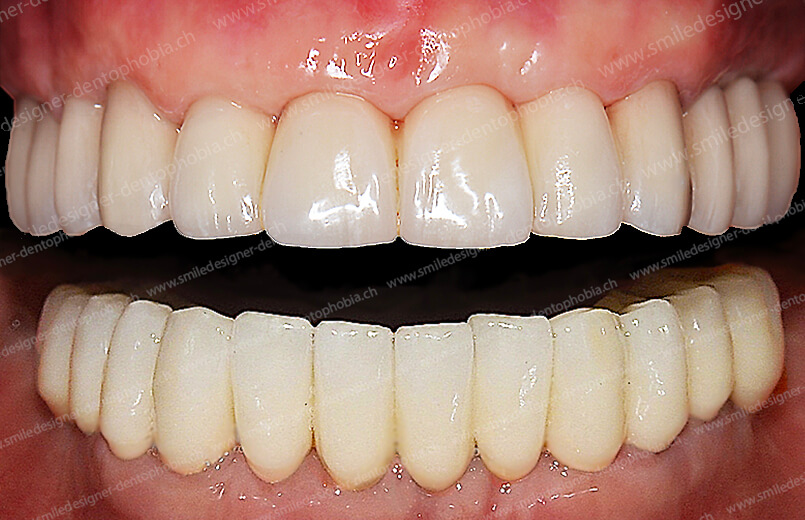
Notre résultat : votre tout nouveau sourire en une seule intervention de pose d’implants et la délivrance des deux bridges implanto-portés résilient avec un cosmétique en composite, en Mise en Charge et esthétique Immédiate, quelques jours plus tard.
Voir le détail du protocole et des cas cliniques dans les chapitres correspondants.
Avertissement : Même si nous affichons des résultats cliniques satisfaisants sur nos photos de présentation, ils ne peuvent en aucun cas être des promesses de succès similaires concernant votre propre situation clinique. Chaque personne est différente et les cas cliniques uniques.
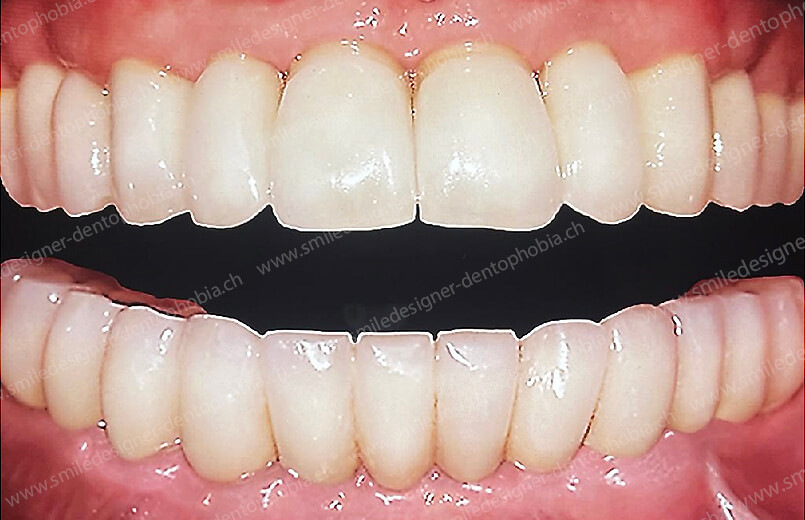
Notre résultat : votre tout nouveau sourire en une seule intervention de pose d’implants et la délivrance des deux bridges implanto-portés résilient avec un cosmétique en composite, en Mise en Charge et esthétique Immédiate, quelques jours plus tard.
Voir le détail du protocole et des cas cliniques dans les chapitres correspondants.
Avertissement : Même si nous affichons des résultats cliniques satisfaisants sur nos photos de présentation, ils ne peuvent en aucun cas être des promesses de succès similaires concernant votre propre situation clinique. Chaque personne est différente et les cas cliniques uniques.
Nos solutions pour gérer la stomatophie et les cas cliniques d'édentements complexes avec une forte résorption osseuse.
En réalité nous n’avons rien inventé ! Nous avons simplement transposé et adapté toutes les techniques qui s’appliquent en médecine et en chirurgie médicale générale à la dentisterie et en particulier à l’implantologie orale.
La solution au problème de la stomatophobie est très simple : utiliser les techniques médicales.
Il suffit simplement d’utiliser les techniques d’anesthésie qui prévalent dans le monde médical pour n’importe quelles interventions chirurgicales.
Les patients sont sédatés avec des techniques réalisées par nos médecins anesthésistes comme des sédations par voie intraveineuses qui sont décrites dans le chapitre que vous pouvez consulter en cliquant ici.
Soit, il suffit simplement d’utiliser les techniques d’anesthésie avec une hospitalisation en clinique et des interventions réalisées sous anesthésie générale. La description de ce protocole est dans le chapitre que vous pouvez consulter en cliquant ici.
La solution au problème de la gestion des cas cliniques d’édentements complexes avec une forte résorption osseuses est également très simple : il relève de l’application des techniques de chirurgies orales pré-implantaires, boostées par les nouveaux paradigmes de la dentisterie régénérative.
Nous avons donc mis en place une solution intermédiaire qui puisse résoudre immédiatement la plupart des problèmes de ces personnes en situation de péril infectieux, psychologiques et de désocialisation, sans fermer aucune porte thérapeutique, nécessaire pour optimiser leur situation clinique dans le futur.
C’est notre solution 3 : « Damage Control MCI »: cliquez ici.
Cette solution 3 « Damage control MCI » vient au secours des deux premières dans les cas de résorption osseuses plus importante:
La solution 1 : « Gold Standard MCI » peut être pratiquée lorsque la résorption osseuse est trés faible et que tous les implants peuvent être posés de prime abord ou que des chirurgies de greffes pré-implantaires puissent être faites au préalable, sans urgence ni stress, pour restaurer tous les secteurs de l’arcade dentaire ad integrum.
La solution 2 : « Gold Damage Control MCI » peut être pratiquée lorsque la résorption osseuse est moyenne et que presque tous les implants peuvent être posés de prime abord pour restaurer les secteurs postérieurs ad integrum.
L’astuce des extensions postérieures molaires permet de s’exonérer de faire des chirurgies de greffes pré-implantaires.
La solution 3 : « Damage Control MCI » est pratiquée lorsque les deux autres solutions ne sont pas possible car la résorption osseuse est forte ou trés forte. Tous les implants ne peuvent pas être posés de prime abord et des chirurgies de greffes pré-implantaire ne peuvent pas être faites au préalable.
L’urgence et la gestion du stress commande de restaurer l’intégrité physique du patient.
A la suite de la conduite de notre protocole numéro 3 « Damage Control MCI », nous allons nous trouver dans deux cas de figure :
Dans le premier cas de figure : le plus favorable, le « Damage Control MCI » a rempli complètement ses missions de sauvetage du patient et de quasi restitutio ad integrum de l’arcade dentaire.
Comme notre protocole est une thérapeutique extrêmement puissante, nous arrivons, en général, à mettre suffisamment d’implants dans le secteur antérieur et les deux secteurs latéraux pour restaurer complètement l’arcade dentaire. Cette solution restaure le secteur antérieur ad integrum et les secteurs postérieurs quasiment ad integrum. À condition de créer deux extensions postérieures aux extrémités postérieures du bridge implanto-portée en mise en charge immédiate, pour remplacer les premières molaires.
Dans ce cas la solution numéro trois, « Damage Control MCI », a rempli sa mission de sauvetage et le patient peut choisir de rester dans cette situation puisqu’il va avoir 12 dents nécessaires et suffisantes de première molaire droite à première molaire gauche.
Il a reconstruit les secteurs postérieurs des arcades dentaires, même partiellement, sa fonction masticatrice et son esthétique du sourire.
Dans le deuxième cas de figure: le « Damage Control MCI » a rempli complètement sa première mission de sauvetage du patient MAIS trop partiellement celle de la reconstruction de l’arcade dentaire postérieure et de la mastication.
Comme notre protocole est une thérapeutique extrêmement puissante, il a restauré immédiatement les personnes en errance médicale. En effet, nous arrivons a mettre suffisamment d’implants dans le secteur antérieur pour reconstruire l’esthétique des dents du sourire afin d’éviter une désocialisation du patient.
Mais dans le cas de figure où les deux secteurs latéraux ont une crête osseuse alvéolaire très résorbée, il est difficile de poser des implants dans ses zones postérieur et donc de restaurer complètement l’arcade dentaire et la mastication.
En revanche, il est possible de créer deux extensions postérieures aux extrémités postérieures du bridge implanto-portée en mise en charge immédiate, pour remplacer les prémolaires.
Mais comme nous l’avons vu plus haut ce calage prémolaire et molaire est insuffisant pour une mastication efficace et une bonne santé des articulations temporo-mandibulaires.
L’optimisation clinique des secteurs postérieurs, suite à la au sauvetage des secteurs antérieurs et le débuts des secteurs latéraux grâce au « Damage Control »:
Une fois ce premier sauvetage réalisé grâce au « Damage Control MCI », nous arrivons au fils du temps à reconstruire les secteurs postérieurs pour ajouter des implants dans ces zones et augmenter la reconstruction des maxillaires jusqu’à un résultat « ad integrum » de type « Gold Standard MCI » ou « Gold Damage Control MCI ».
C’est-à-dire une reconstruction complète de toutes les arcades dentaires, de la fonction masticatrice, et de l’esthétique du sourire.
A ce niveau de réflexion, nos protocoles de reconstruction des maxillaires décrites dans notre solution numéro quatre « DOMINO SURGERIES MCI » prend tout son intérêt :
Il existe des situations cliniques encore plus catastrophiques qui présente une résorption quasiment terminale des secteurs maxillaires osseux postérieurs.
Dans ces situations, il est même pas possible de mettre des implants au niveau des zones prémolaires, mais uniquement au niveau du secteur antérieur du sourire dans le meilleur des cas, avec comme limite implantable les canines de droite à gauche.
Notre solution « Domino Surgeries » est conçue pour mettre en place une première phase de sauvetage de cette situation clinique extrême : nous arrivons à remplacer par des implants dentaires et un bridge implanto-porté de sauvetage, la zone des dents du sourire avec de toutes petites extensions postérieures au niveau des premières prémolaires.
Suite à cette première phase de pose d’implants en mise en charge immédiate, réalisée dans l’urgence relative pour restaurer le secteur antérieur et remettre le patient dans une dynamique sociale positive, s’en suit toute une série d’interventions chirurgicales pré-implantaires en cascade, qui, petit à petit grâce à un effet domino, reconstruisent tous les secteurs postérieurs des maxillaires. En particulier, le maxillaire supérieur qui est le plus souvent le plus atrophié.
Ces protocoles de reconstruction des arcades dentaires de sauvetage en cascade sont décrits dans le chapitre « Domino surgeries ».
C’est notre solution 4 « Domino Surgeries MCI », cliquez ici pour en savoir plus.
La solution ultime des implants zygomatiques
Il existe un stade ultime d’atrophie des maxillaires, totale et terminale.
Dans ce cas, il est très difficile d’utiliser les protocoles précédents et revenir à une situation clinique qu’il soit implantable de façon classique.
Il existe toutefois une alternative à l’appareil dentaire qui est dans ces cas là la pose d’implants zygomatiques avec une mise en charge immédiate pat un prothèse dentaire provisoire qui sera remplacé 6 mois plus tardera un prothèse définitive.
Cette solution est à haut risque car elle fait intervenir l’os basal du maxillaire supérieur et le pied de l’os de la pommette (zygomatique). En cas d’aléas, c’est cette zone qui sera touchée.
Ce protocole chirurgical est réservé à des opérateurs trés chevronnée en général médecin maxillo-facial et uniquement en situation d’hospitalisation en clinique.
C’est notre solution 6 : « zygomatique«
Smile Designer, dans ces cas de figure, peut vous orienter vers des cabinets de médecine maxillo-faciale spécialisés.
Quels sont les avantages et les contraintes de la pose des implants dentaires en mise en esthétique et en charge immédiate
La pose des implants dentaires en Mise en Esthétique et en Charge Immédiate : est une approche, parmi les plus modernes et les plus abouties, pour le remplacement de novo des arcades dentaires très délabrées.
La pose des implants dentaires en Mise en Esthétique et en Charge Immédiate : c’est une seule intervention chirurgicale, le plus souvent dans un bloc opératoire sous anesthésie générale. Elle permet de poser une prothèse implanto-portée qui remplace toutes les dents du sourire et souvent les dents masticatrices en moins d’une semaine.
Cette prothèse implanto-portée remplace la majeur partie des dents dont celles du sourire : C’est un bridge esthétique prototype qui remplace toute ou partie de vos dents condamnées ou d’ores et déjà absentes.
La pose des implants dentaires en Mise en Esthétique et en Charge Immédiate est actuellement un des protocoles qui permet d’espérer un résultat esthétique optimisé. Il associe à la pose des implants, des greffes osseuses, la dentisterie régénérative (PRF) et les technologies numériques 3D (Radiologie et CFAO).
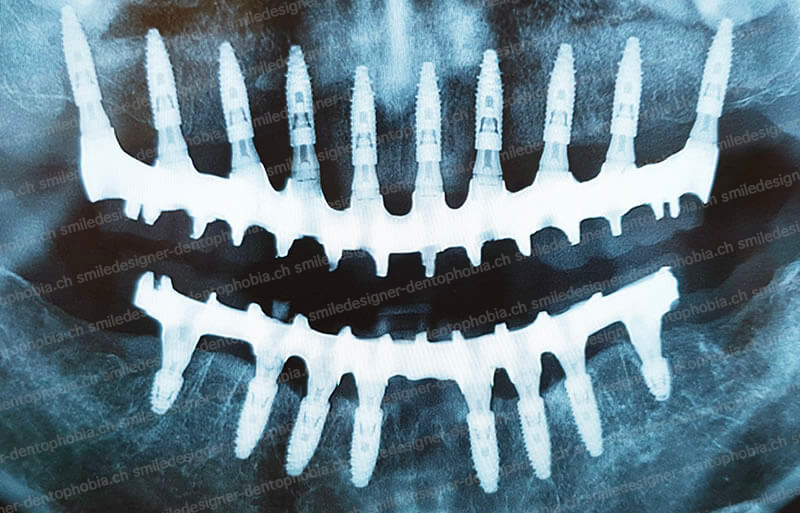
Les protocoles expliqués en vidéos :
une de nos chirurgies de pose d'implants en MCI
une de nos CHIRURGIEs de greffe osseuse sous-sinusienne - sinus lift -
Attention, ces vidéos filment des interventions chirurgicales. Elles peuvent heurter la sensibilité de certaines personnes.
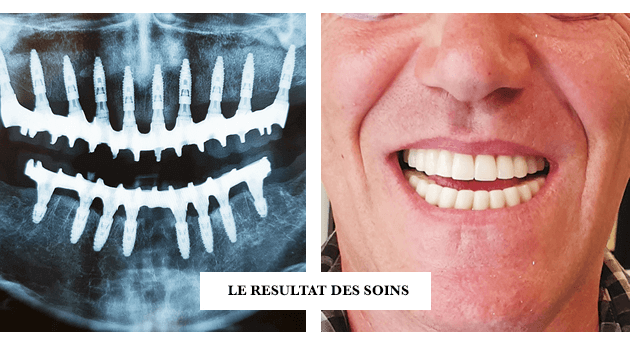
LE FILM DE LA POSE DES "IMPLANTS EN MISE EN ESTHÉTIQUE ET EN CHARGE IMMÉDIATE"
UNE CHIRURGIE DE POSE D'IMPLANTS EN "MCI":
LA RIGUEUR DE LA MÉTHODE DE LA POSE D'IMPLANTS EN MCI BI-MAXILLAIRE
SOUS ANESTHÉSIE GÉNÉRALE
LE FILM D'UNE INTERVENTION DE COMBLMENT DE SINUS OU"SINUS LIFT" AVEC L'APPORT DE LA DENTISTERIE RÉGÉNÉRATIVE : LE "PRF"
La chirurgie du "sinus lift".
le prérequis à la pose des implants en MCI
SOUS ANESTHÉSIE GÉNÉRALE
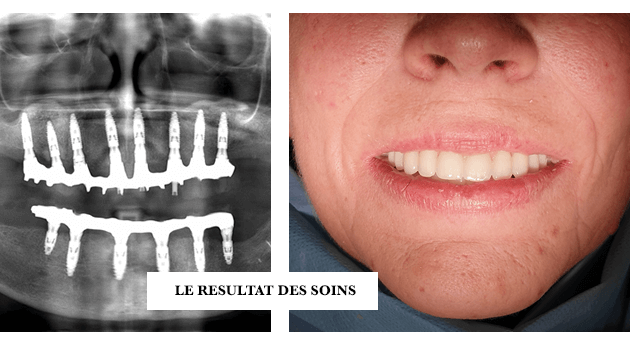
VOUS ÊTES UNIQUE !
CAS CLINIQUES DE RECONSTRUCTION DU SOURIRE AVEC NOS SOLUTIONS IMPLANTAIRES EN MCI
NOUS RÉPONDONS à vos QUESTIONS
sur l'implantologie avec Mise en ESTHÉTIQUE ET EN Charge Immédiate
Le médecin-dentiste répond à vos questions les plus fréquemment posées.
Si votre question n’est pas mentionnée, veuillez prendre rdv pour une téléconsultation et une réponse précise.
Non. Cela n’existe pas. Le médecin dentiste doit choisir dans son panel de techniques celles qui s’approchent le plus des besoins et des désirs des patients.
C’est au praticien implantologue de proposer des solutions implantaires pour gérer l’édentement total du patient mais c’est aux patients de choisir LA solution qui lui convient le mieux.
Il faut absolument comprendre que chacun des protocoles a des indications et des contre-indications, des avantages et des inconvénients.
A aucun moment dans ces chapitres de vulgarisation, il doit être compris que tous les cas clinique peuvent être traités de la même manière, de façon universelle.
La demande des médecins dentistes dans les protocoles modernes qui leur sont proposés est autant une restauration de la fonction, que de l’anatomie et de l’esthétique.
C’est bien sûr, aussi, celle des patients.
Mais, plus encore les concernant, leurs demandes sont un gommage complet de leurs mutilations, de leurs souffrances physiques et morales, la restauration de l’esprit et de leur vie qui a basculé.
C’est pour cela que la dentisterie moderne utilise de plus en plus fréquemment des techniques de restauration dentaire avec des implants et la mise en charge immédiate ou MCI.
Pour autant, le choix de la technique est essentiellement basé sur les conditions anatomiques initiales du patient, ses critères biologiques et sa condition financière.
En regard de ses exigences, il faut une disponibilité des professionnels dans la zone de confort des patients et les compétences requises. La raréfaction des professionnelles rend ces choses difficiles.
Pour autant, grâce à l’information sur internet et les réseaux sociaux et la communication direct ubiquitaire en vidéo rendez-vous, les patients se déplacent de plus en plus et vont chercher leurs praticiens là où ils trouvent leurs critères de choix.
C’est ici que l’imagerie moderne numérique prend toute son importance.
La radiologie 3D et la photographie 3D moderne permet de faire une « copie numérique » du patient et de le dématérialiser.
Les fichiers radiologiques 2D et 3D scanners, les photos et les données biologiques peuvent être envoyées de n’importe quel point du monde vers un autre.
Ainsi un patient peut être diagnostiqué à distance par internet et recevoir une information.
- Le premier intérêt est d’optimiser l’esthétique de la gencive (tissus mous) qui va cicatriser autour des reconstructions prothétiques implanto-portées de type bridge complet en composite ou en céramique. Grâce à la maturation esthétique précoce du festonnage gingival autour des plateformes vissées dans les implants dentaires, les contours esthétiques de la prothèse dentaire sont ainsi beaucoup mieux gérés et le rendu général est très naturel.
- Le deuxième intérêt est d’optimiser la cicatrisation osseuse autour des implants: comme des broches d’ostéosynthèse immobilisent les os lors d’une fracture osseuse dans un membre.
- Le troisième intérêt est que ce protocole exonère le patient de porter de fastidieuses prothèses provisoires amovibles (dentier). D’autant plus, que le port d’une prothèse amovible alors que les implants sont en nourrice sous la gencive risque de mobiliser les implants et ruiner la cicatrisation par ostéo-intégration. Rester édenté le temps de l’ostéointégration est l’option la plus sûr pour bien cicatriser. Mais les patients sont associalisés. Grâce aux techniques de mise en charge, immédiatement après la pose des implants dentaires suite aux extractions dentaires sur toutes l’arcade, ce problème d’associalisation est évité sans perturbation de la cicatrisation et même en la favorisant.
Par défaut, notre protocole MCI pionnier consiste à effectuer simultanément les interventions suivantes, en une seule chirurgie, dites en « one shot » :
- Extraire toutes les dents restantes lors de la chirurgie ;
- Poser des implants dentaires immédiatement en remplacement de celles-ci ;
- Placer une greffe osseuse allogénique, pour boucher les lacunes osseuses entre les implants dentaires et parois des alvéoles dentaires après les extractions dentaires. Egalement pour “sur-greffer” les parois osseuses buccales et anticiper les résorptions osseuses post extractionnelles : ce point est fondamentale pour restructurer esthétique du festonnage gingivale autour des couronnes prothétiques céramiques sur implants ;
- Charger les greffes osseuses de iPRF (Plasma Rich Fibrin). L’apport de PRF sous sa forme injectable dans le greffon osseux permet un apport de facteurs de croissance cellulaires déterminants dans la conduite du protocole de MCI. Les facteurs cicatriciels contenus dans les concentrés sanguins autologues, favorisent l’angiogénèse et la formation d’une néo vascularisation tant dans l’os des mâchoires (tissus durs) que dans la gencive (les tissus mous) ;
- Recouvrir les greffes osseuses de aPRF (Plasma Rich Fibrin), afin comme précédemment, d’optimiser la cicatrisation osseuse et gingivale ;
- Suturer les plaies avec des membranes de aPRF afin de ne pas créer de tension gingivale en tractant les lambeaux ;
- Réaliser une empreinte pour enregistrer le positionnement des implants posés ;
- Fabriquer le bridge implanto-porté résilient en composite sous 2 à 3 jours et le visser sur les implants pour les immobiliser.
Le critère principal est la mesure du volume osseux disponible implantable lors de l’examen initial radiologique grâce au scanner 3D.
C’est ce critère qui va déterminer si on peut mettre suffisamment d’implants dentaires afin de supporter le poids de la mastication sur une prothèse fixe implanto-portée.
D’une façon très schématique, on va définir dans le chapitre « l’univers de la MCI » plusieurs groupes de solutions pour restaurer les arcades dentaires par une prothèse dentaire implanto-portée fixe. En particulier pour le maxillaire plus ou moins atrophique.
Bien évidement, chaque cas est particulier.
Seule une étude attentive du cas clinique, des besoins, des désirs et du niveau d’exigence des patients peut aboutir à un choix de plan de traitement.



